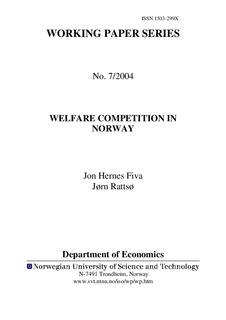| dc.contributor.author | Fiva, Jon Hernes | nb_NO |
| dc.contributor.author | Rattsø, Jørn | nb_NO |
| dc.date.accessioned | 2014-12-19T14:31:51Z | |
| dc.date.available | 2014-12-19T14:31:51Z | |
| dc.date.created | 2006-10-04 | nb_NO |
| dc.date.issued | 2004 | nb_NO |
| dc.identifier | 126095 | nb_NO |
| dc.identifier.uri | http://hdl.handle.net/11250/267123 | |
| dc.description.abstract | Local redistribution policy creates incentives for welfare migration that may result in 'underprovision' or even a 'race to the bottom'. This paper evaluates the empirical importance of welfare competition. Our contribution is to separate between the policy decision and the actual welfare benefit payments and to introduce income distribution as a determinant of welfare policy. Utilizing spatial econometric methods we find statistical significant strategic interaction between local governments for both the welfare benefit norm decided by the local council and the expected welfare benefits of a standardized person. No robust relationship is found between inequality and welfare benefits and thus we offer no strong support for the Romer-Meltzer-Richard hypothesis. We conclude that there is a geographic pattern in welfare benefits. This does not necessarily imply underprovision, since the grant financing of the local governments may generate overall excessive public spending. | nb_NO |
| dc.language | eng | nb_NO |
| dc.publisher | Institutt for samfunnsøkonomi | nb_NO |
| dc.relation.ispartofseries | Working Paper Series, 1503-299X; 2004:7 | nb_NO |
| dc.title | Welfare Competition in Norway | nb_NO |
| dc.type | Research report | nb_NO |
| dc.contributor.department | Norges teknisk-naturvitenskapelige universitet, Fakultet for samfunnsvitenskap og teknologiledelse, Institutt for samfunnsøkonomi | nb_NO |
